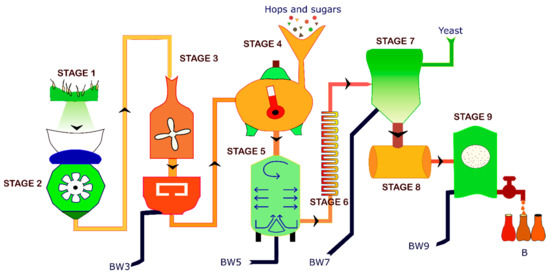Valorizing the Unexplored Filtration Waste of Brewing Industry for Green Silver Nanocomposite Synthesis
N. V. Rangam, A. Johnson Sudagar, A. Ruszczak, P. Borowicz, J. Tóth, L. Kövér, D. Michałowska, M. Ł. Roszko, K. R. Noworyta, B. Lesiak
Nanomaterials 2022, 12, 44
Abstract
 The brewing industry generates a substantial amount of by-products rich in polyphenols, carbohydrates, sugars, sulfates, nitrogen compounds, organic carbon, and several elements, including chlorine, magnesium, and phosphorus. Although limited quantities of these by-products are used in fertilizers and composts, a large amount is discarded as waste. Therefore, it is crucial to identify different ways of valorizing the by-products. Research regarding the valorization of the brewery by-products is still in its nascent stage; therefore, it still has high potential. Herein, we report the valorization of the brewery by-product from the filtration stage of the brewing process (BW9) to synthesize silver nanocomposites as this waste has remained largely unexplored. The BW9 nanocomposites have been compared to those obtained from the brewery product B. The chemical composition analysis of BW9 and B revealed several organic moieties capable of reducing metal salts and capping the formed nanoparticles. Therefore, the brewery waste from stage 9 was valorized as a precursor and added to silver-based precursor at various temperatures (25, 50, and 80 °C) and for various time periods (10, 30, and 120 min) to synthesize silver nanocomposites. The nanocomposites obtained using BW9 were compared to those obtained using the main product of the brewing industry, beer (B). Synthesized nanocomposites composed of AgCl as a major phase and silver metal (Agmet) was incorporated in minor quantities. In addition, Ag3PO4 was also found in B nanocomposites in minor quantities (up to 34 wt.%). The surface morphology depicted globular nanoparticles with layered structures. Small ball-like aggregates on the layer representative of Ag3PO4 were observed in B nanocomposites. The surface of nanocomposites was capped with organic content and functional groups present in the brewery products. The nanocomposites demonstrated high antibacterial activity against Escherichia coli (E. coli), with BW9 nanocomposites exhibiting a higher activity than B nanocomposites.
The brewing industry generates a substantial amount of by-products rich in polyphenols, carbohydrates, sugars, sulfates, nitrogen compounds, organic carbon, and several elements, including chlorine, magnesium, and phosphorus. Although limited quantities of these by-products are used in fertilizers and composts, a large amount is discarded as waste. Therefore, it is crucial to identify different ways of valorizing the by-products. Research regarding the valorization of the brewery by-products is still in its nascent stage; therefore, it still has high potential. Herein, we report the valorization of the brewery by-product from the filtration stage of the brewing process (BW9) to synthesize silver nanocomposites as this waste has remained largely unexplored. The BW9 nanocomposites have been compared to those obtained from the brewery product B. The chemical composition analysis of BW9 and B revealed several organic moieties capable of reducing metal salts and capping the formed nanoparticles. Therefore, the brewery waste from stage 9 was valorized as a precursor and added to silver-based precursor at various temperatures (25, 50, and 80 °C) and for various time periods (10, 30, and 120 min) to synthesize silver nanocomposites. The nanocomposites obtained using BW9 were compared to those obtained using the main product of the brewing industry, beer (B). Synthesized nanocomposites composed of AgCl as a major phase and silver metal (Agmet) was incorporated in minor quantities. In addition, Ag3PO4 was also found in B nanocomposites in minor quantities (up to 34 wt.%). The surface morphology depicted globular nanoparticles with layered structures. Small ball-like aggregates on the layer representative of Ag3PO4 were observed in B nanocomposites. The surface of nanocomposites was capped with organic content and functional groups present in the brewery products. The nanocomposites demonstrated high antibacterial activity against Escherichia coli (E. coli), with BW9 nanocomposites exhibiting a higher activity than B nanocomposites.



